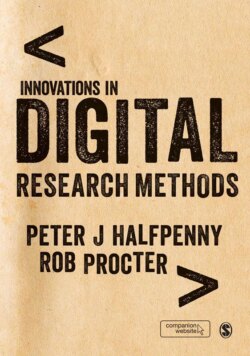Читать книгу Innovations in Digital Research Methods - Группа авторов - Страница 49
На сайте Литреса книга снята с продажи.
2.3.3 Data on Health and Well-being
ОглавлениеThe Health Survey of England (HSE)51 and the English Longitudinal Study of Ageing (ELSA)52 are two key surveys for examining health outcomes. The HSE is a representative survey of around 15,000 adults and children in England. It combines data on attitudes towards health, eating and exercise with physiological data. Core topics include: general health, smoking, drinking, fruit and vegetable consumption, height, weight, blood and saliva samples. Special topics include: cardiovascular disease, physical activity, accidents, lung function measurement, blood pressure and certain blood components. The data is geo-coded to Government Office Region (GOR) level.
ELSA is a longitudinal survey of around 11,000 people aged 50+ in England, which began in 2002. It includes information on key demographics, income, health and cognitive function. Both HSE and ELSA data are freely available and more detailed versions including additional variables and more detailed geographic information are available as restricted access via the Secure Data Service under strict terms of use.
Other sources of health data include consequential data such as General Practitioner (GP) prescribing records. The ADLS is facilitating access to such data by building links with data holders, developing standards and good practice for data sharing and providing training for researchers in safe handling, analysis and publication from such data.53 Real time prescription data would be a very powerful tool for mapping changes in health and well-being.
The UK Biobank has collated for research purposes genetic and other physiological and behaviour data donated by over half a million citizens for research purposes.54 Genomic data are a potentially invaluable research tool for the social sciences as well as health sciences. This includes studies where researchers use surveys of twins to try to identify the impacts of both contextual and inherited covariates. For example, research by Sturgis et al. (2010), which involved combining attitude data and physiological information, examined the genetic basis for social trust. In the Millennium Cohort Study,55 the collection of DNA from data subjects linked to the survey data is becoming more common. This resource has great potential as it allows the possibility of tracking genetic and environmental influences across the life course. As well as these intentional research resources, several commercial DNA profiling organizations have been set up, for example, Britain’s DNA, where the public are asked to donate a DNA sample.56
Other sources of health data include data traces of online searches recording patterns of health-related queries. Though there is some debate about the accuracy of such methods, the content of tweets and volumes has been shown to be of value in monitoring the spread of flu outbreaks,57 as have Wikipedia searches (see Ortiz et al., 2011; McIver and Brownstein, 2014).
Similarly, social media postings on health forums can also be collated and analysed. For example, in this anonymized Mumsnet post, a contributor seeks advice about what to do about a potential case of flu:
Not sure if this is just a bad cold or something worse but daughter and I both have it and husband, who’s had the flu jab, is fine. Is this risky to the baby? Do I go to the GP in the morning? I thought you weren’t supposed to go to the GP with flu symptoms in case you spread it about? Should I look out for reduced movements? argh don’t know what I’m supposed to do! Someone please advise as NHS Direct is on a four-hour call back. (‘ISS’, 2011)
Here a social science researcher could code for information including: language, location references, health, flu, use of services, anxiety levels, gender, responsibility for health within the family and health communication issues. The researcher could also look at replies and related posts. Such self-published data are rich in detail and of great potential value in providing examples of individual experiences. Innovation in research design and sampling techniques could aid the development of research that could go beyond qualitative data and individual stories.
It is notable that in health research, crowdsourced data gathering techniques have also been used as part of structured research projects. Examples include researchers using social media to identify people with specific diseases and using online discussion groups to identify examples of side effects of particular drugs. People identified in this way may then be asked to take part in follow-up studies. These developments have been described as akin to an ‘eBay for health research’, where researchers seek to recruit participants or where people might put themselves forward for participation in studies (Swan, 2012).58 For health research, a link could also be made to administrative data and FOI requests, such as for data held on government meeting notes in relation to disease monitoring and decisions on vaccination programmes and drug stock piling.
